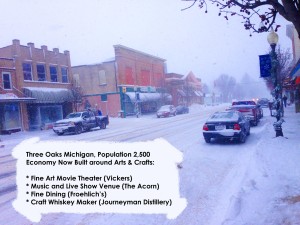 Rural Development Hinges On The Creative Class
Rural Development Hinges On The Creative Class
Attracting the Creative Class is About Culture, Tolerance, and Quality of Life
Where Creative Workers Locate is Where Innovation and New Businesses Happen, Site Locations Follow
Richard Florida is, in my view, the top theorist in the USA with regards to economic development. His seminal book the Rise of the Creative Class should be required reading for anyone with an interest in creating jobs, and attracting companies to locate in a particular region (his other work is also notable). Florida is not without controversy, but I respect his work because it’s data-driven, and, because I’ve seen his theories play out in the real world. The skinny on Florida’s theories is pretty simple: creative workers drive regional economies.
This was always true with cities like Austin and San Francisco, but new data is proving it’s true in rural America as well.
 His recent article, The Innovations of the Creative Class Affect a Rural Area’s Fortunes, is another wise Florida perspective, based on the data, about the unique challenges faced by rural areas. His main point: the data shows that rural areas that develop and maintain Creative Class workers, innovate more, and improve the economy of the area. It’s interesting that rural areas may have an even bigger opportunity for impact on the local economy than their better resourced urban rivals — IF they attract and retain creative workers.
His recent article, The Innovations of the Creative Class Affect a Rural Area’s Fortunes, is another wise Florida perspective, based on the data, about the unique challenges faced by rural areas. His main point: the data shows that rural areas that develop and maintain Creative Class workers, innovate more, and improve the economy of the area. It’s interesting that rural areas may have an even bigger opportunity for impact on the local economy than their better resourced urban rivals — IF they attract and retain creative workers.
Sounds simple, but of course, it’s not.
As always the devil is in the details. Just how does a community encourage creative workers to locate there? Well, there are ways, and that’s a complex problem that begs for a context-area-specific workshop. It can be done.
It’s About Culture and Tolerance
It’s a chicken and egg sort of dilemma. On the one hand, rural areas have lower costs of living, inexpensive office or maker spaces, more peace and quiet, and in some areas, more outside recreational activities. On the other hand, rural areas often have poor internet access, and, fewer cultural offerings. The local culture is a big factor folks. Why do people drive for hours to get to Marfa, Texas? Da culcha!
By cultural offerings, I’m talking about the arts, and also the “feel” of an area, particularly with regard to tolerance. Things like plays, musical performances, art galleries, museums, parks, recreational sports, festivals, poetry readings, fine art films, book clubs, and “foodie” restaurants, night clubs, cool coffee shops are what creative people like. Local universities and other interesting educational opportunities can also be considered local culture. To a large extent, it’s about openness to different sorts of people as well. Rural areas that are closed off to outsiders, or have a reputation for bigotry, discrimination, or intolerance aren’t going to attract creatives. But, if a nice mixture of cultural activities are rich enough, and communities are welcoming, it attracts, and retains, talented people. Those people start businesses in their new community to sustain their lifestyles. That’s what starts a positive upward spiral.
Creatives aren’t just artists — they’re entrepreneurs, inventors, and business innovators. Because creatives are often non-conformists, they start businesses where they can control their own destiny. When I say non-conformist, think beyond someone with purple hair in spikes, think more like Steve Jobs, Elon Musk, or Debbie Fields. Imagine a small town with a nearly abandoned main street. Then fill a half dozen of those store-fronts with unique small businesses. It makes a huge difference in how an area looks, and feels. This is a building block for attracting a big company. Does this stimulate any ideas for projects?
Rural areas have a particularly hard time attracting new jobs, or new locations of big businesses. Rural areas are also inhibited in doing innovation on their own from scratch, largely due to lack of talent, resources and support services. Rural areas tend to be resource poor, and to some extent, infrastructure poor. There is talent in rural areas, but, that talent often drifts away towards areas where there are better job opportunities, AND, better cultural offerings, AND, greater tolerance.
Small Culture Building Projects are Baby Steps
Doesn’t that suggest a certain kind of project? My bottom line: If you’re an economic developer (or government official/chamber of commerce person) small projects that build Culture are something you should start doing now, and continue on a regular basis. Yes, wouldn’t it be great if you became the next Amazon location, but that’s not going to happen until you show a big company that you’ve got a community worth living in.
You need to put the creative horse in place — in order to pull your innovation and business location cart.
How Gregg Fraley Innovation (GFi) Can Help
What’s your first project and the next set of projects? That’s where professional facilitators with economic development experience can assist. There’s a process for identifying opportunity areas, leveraging the assets you have, and then jamming ideas for how to get a project going and completed. It’s not rocket science, and it is work, but the process is effective. Get in touch and I’ll tell you more.
********** *********** ************
Other posts by Gregg Fraley related to Economic Development that might be of interest:


